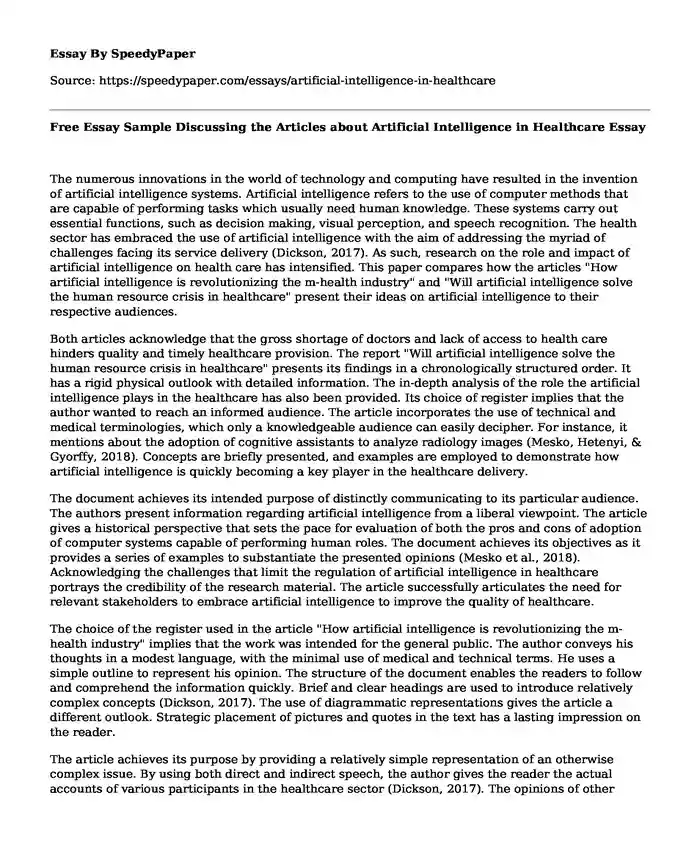
| Type of paper: | Article review |
| Categories: | Healthcare Artificial intelligence |
| Pages: | 3 |
| Wordcount: | 724 words |
The numerous innovations in the world of technology and computing have resulted in the invention of artificial intelligence systems. Artificial intelligence refers to the use of computer methods that are capable of performing tasks which usually need human knowledge. These systems carry out essential functions, such as decision making, visual perception, and speech recognition. The health sector has embraced the use of artificial intelligence with the aim of addressing the myriad of challenges facing its service delivery (Dickson, 2017). As such, research on the role and impact of artificial intelligence on health care has intensified. This paper compares how the articles "How artificial intelligence is revolutionizing the m-health industry" and "Will artificial intelligence solve the human resource crisis in healthcare" present their ideas on artificial intelligence to their respective audiences.
Both articles acknowledge that the gross shortage of doctors and lack of access to health care hinders quality and timely healthcare provision. The report "Will artificial intelligence solve the human resource crisis in healthcare" presents its findings in a chronologically structured order. It has a rigid physical outlook with detailed information. The in-depth analysis of the role the artificial intelligence plays in the healthcare has also been provided. Its choice of register implies that the author wanted to reach an informed audience. The article incorporates the use of technical and medical terminologies, which only a knowledgeable audience can easily decipher. For instance, it mentions about the adoption of cognitive assistants to analyze radiology images (Mesko, Hetenyi, & Gyorffy, 2018). Concepts are briefly presented, and examples are employed to demonstrate how artificial intelligence is quickly becoming a key player in the healthcare delivery.
The document achieves its intended purpose of distinctly communicating to its particular audience. The authors present information regarding artificial intelligence from a liberal viewpoint. The article gives a historical perspective that sets the pace for evaluation of both the pros and cons of adoption of computer systems capable of performing human roles. The document achieves its objectives as it provides a series of examples to substantiate the presented opinions (Mesko et al., 2018). Acknowledging the challenges that limit the regulation of artificial intelligence in healthcare portrays the credibility of the research material. The article successfully articulates the need for relevant stakeholders to embrace artificial intelligence to improve the quality of healthcare.
The choice of the register used in the article "How artificial intelligence is revolutionizing the m-health industry" implies that the work was intended for the general public. The author conveys his thoughts in a modest language, with the minimal use of medical and technical terms. He uses a simple outline to represent his opinion. The structure of the document enables the readers to follow and comprehend the information quickly. Brief and clear headings are used to introduce relatively complex concepts (Dickson, 2017). The use of diagrammatic representations gives the article a different outlook. Strategic placement of pictures and quotes in the text has a lasting impression on the reader.
The article achieves its purpose by providing a relatively simple representation of an otherwise complex issue. By using both direct and indirect speech, the author gives the reader the actual accounts of various participants in the healthcare sector (Dickson, 2017). The opinions of other professionals in the medical technology add credibility to the paper. The audience can conclude from the article that artificial intelligence can change the scope of healthcare delivery across the globe. In addition, readers can easily infer that cognitive assistants will result in automation of some process. Thus, doctors will have the opportunity to focus on crucial tasks such as disease prevention and fostering wellness.
In conclusion, it is clear that both articles present valid ideas on the adoption of artificial intelligence in the healthcare sector. Despite the differences in the mode and language of presentation, their target audiences receive the intended message. Whereas one article adopts a formal format, the other uses a simple approach to present its findings. The two documents successfully serve their purpose regardless of their differences. They both accurately portray the progress made in healthcare, its challenges, and the apparent threat it poses.
References
Dickson, B. (2017, September). How artificial intelligence is revolutionizing the mhealth industry. PC Magazine. Retrieved from www.magzter.com/articles/1642/241037/59c9590a889f7
Mesko, B., Hetenyi, G., & Gyorffy, Z. (2018). Will artificial intelligence solve the human resource crisis in healthcare? BMC Health Services Research, 18(1), 545.
Cite this page
Free Essay Sample Discussing the Articles about Artificial Intelligence in Healthcare. (2022, Feb 14). Retrieved from https://speedypaper.net/essays/artificial-intelligence-in-healthcare
Request Removal
If you are the original author of this essay and no longer wish to have it published on the SpeedyPaper website, please click below to request its removal:
- Essay Samples on Saint Paul John the Great
- Essay Sample on Regular Exercise for Students in Community Colleges
- Essay Example: General Principles of Healthcare Budgeting
- Free Essay on Marketing in Fashion Industry
- Free Essay Example on Amazon Information Systems
- Compare and Contrast Essay on Death of a Salesman and Tragedy of Hamlet
- Paper Example: Career Development Application Paper
Popular categories




